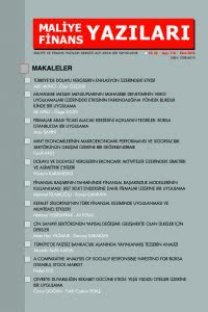Kamu İşletmelerinin Rekabet Gücü Analizi Ve Ulaştırma Sektörü Örneği
Rekabet günümüzün iş yaşamının bir gerçeğidir, her alanda oldukça yoğun bir
şekilde görünmektedir. Her geçen gün üretim sistemlerinde değişiklikler
olmakta, yeni teknolojiler geliştirilmekte ve her sektörde mevcut firmalar ve
kuruluşlar için yeni rakipler ortaya çıkmaktadır. Bu çalışmanın amacı da;
ulaştırma sektöründe kamu yönetiminin rekabet gücünü ve rekabet koşullarının
sektör üzerindeki uygulama örneklerini ele alarak özel sektöre özgü olduğu
düşünülen rekabet kavramının kamu sektörü için de geçerli olabileceğini ortaya
çıkarmaktır. Çalışmada, rekabet ve rekabet gücünün sağlanması ile ilgili
literatür araştırması yapılmış ve elde edilen veriler ışığında kamu sektörünün
de rekabet edebileceği ve özellikle ulaştırma sektöründe sürdürülebilir rekabet
avantajının iyi bir kümelenme sistemi ile sağlanabileceği sonucuna
ulaşılmıştır.
Anahtar Kelimeler:
Rekabet gücü, kamu sektörü
___
- ADAMASCHEK, Bernd (1997), Interkommunaler Leistungsvergleich. Leistung und Innovation durch Wettbewerb (Güthersloh: Verlag Bertelsman 5tiftung, 2. Auflage).
- BTRE-BUREAU OF TRANSPORT AND REGIONAL ECONOMICS (2003), “Rail Infrastructure Pricing: Principles and Practice”, Report 109. http://www.bitre.gov.au/publications/61/Files/btre_r109.pdf
- BURR, Wolfgang / SEIDLMEIER, Heinrich (1998), "Benchmarking in der öffentlichen Verwaltung Anwendungspotentiale und Grenzen aus theoretischer und empirischer Sicht,"BUDAUS, Ditrich / CONRAD, Peter / SCHREYÖGG, Georg (Hrsg), New Public Management (Berlin, New York): 55-92.
- ECMT-EUROPEAN CONFERENCE OF MINISTERS OF TRANSPORT (1996), “Conclusions of Roundtable 103: The Separation of Operations from Infrastructure in the Provision of Railway Services”, 13-14 Haziran 1996, Paris.
- EREN Veysel (2003) Kamu Yönetiminde Rekabet, Rekabetin Kurumsallaştırılması ve
- Rekabet Mekanizmaları, Ankara Üniversitesi, SBF Dergisi, 58-4
- KARAMANOĞLU Canan (2012), “Demiryolu Sektöründe Yapısal Reformlar ve
- Rekabet” Rekabet Kurumu, Uzmanlık Tezleri Serisi No: 117. Ankara
- Leyda, Luz; Rosado, Vega (2006) “The International Competitiveness of Puerto Rico Using the Porter’s Model,” Journal of Global Competitiveness, Volume: 14 (2)
- NEWBERY, D. M. (2000), Privatization, Restructuring, and Regulation of Network Utilities, The MIT Press Cambridge, MA. London.
- ORDOVER J. & R. PITTMAN (1994), “Restructuring the Railway for Competition”, Paper Prepared for the OECD/World Bank Conference on Competition and Regulation in Network Infrastructure Industries, Budapest
- OECD Policy Roundtables (1997), “Railways: Structure, Regulation and Competition Policy” No. DAFFE/CLP(98)1
- OECD, Policy Roundtables (2005), “Structural Reform in the Rail Industry”, No.DAF/COMP(2005)
- Porter, M., E., 1990, The Competitive Advantage of Nations. New York: Free Press, (Republished with a new introduction, 1998.)
- Porter, M.E. (1998). Clusters and the New Economics of Competition. Harvard Business Review. November –December, 1998.
- PIETRANTONIO D. L. ve J. PELKMANS (2004), “The Economics of EU Railway Reform”, College of Europe, Bruges European Economic Policy Briefings No.8
- KUROSAKI F.(2008), An Analysis of Vertical Separation of Railways, Institute for Transport Studies, The Unicersity of Leeds
- THOMPSON L. (1997) ,”World Bank Support for Developing Railways of the World”, Japan Railway&Transport Review, Temmuz 1997, s.4-15.
- Sven Ullring, M.I.T. Norveç Deniz Kümesi The Norwegian Maritime Cluster. 17. Viagene 1987.
- UBAK-ULAŞTIRMA BAKANLIĞI (1998), “Demiryolu Ulaştırması Komisyon Raporu”, 9. Ulaştırma Şurası 8-10 Haziran 2009.
- T.C.D.D. Genel Müdürlüğü (2009), “Demiryolu Sektör Raporu”
- ISSN: 1308-6014
- Yayın Aralığı: Yılda 2 Sayı
- Başlangıç: 2008
- Yayıncı: Maliye ve Finans Yazıları Yayıncılık Ltd. Şti.
Sayıdaki Diğer Makaleler
KREDİ TEMERRÜT TAKASLARI VE BİST-100 ARASINDAKİ İLİŞKİNİN İNCELENMESİ
Ekonomik Öncü Göstergelerinin BES Katılımcı Sayısı Üzerindeki Etkisi
Kamu İşletmelerinin Rekabet Gücü Analizi Ve Ulaştırma Sektörü Örneği
Türkiye’de Petrol Tüketimi ile Ekonomik Büyüme Arasındaki İlişkinin Analizi
